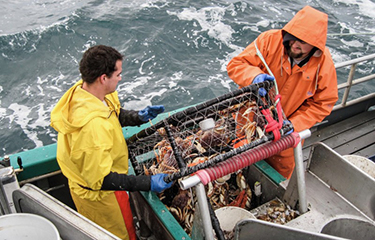The Oregon Department of Fish and Wildlife Commission voted on 4 August to extend limits on Dungeness crab trap gear to protect migrating whales from entanglement.
The commission announced it was considering extending the Dungeness crab fishing restrictions in July, and held a meeting on 4 August to discuss the proposed rule extensions– which include a 20 percent reduction in pot limits across all permits, requiring an additional late-season buoy tag starting 1 May, prohibiting commercial crabbing outside of 40 fathoms starting 1 May, and restricting the amount of surface gear.
The rules on trap numbers, depth sets, and seasonal limits – first set in 2020 – had been coming up for expiration.
At the meeting, commissioners agreed to extend the rules and review them again in two years. Primarily aimed at reducing the danger to humpback whales, Oregon trap limits start with the fishing season in December.
Fishermen said they worry about over-regulation of the Dungeness fishery, which in 2021-2022 landed a record-setting USD 91 million (EUR 83 million) catch, according to the National Marine Fisheries Service.
“Crab fishers don’t want to entangle whales. They just want to make a living,” Michael Pedis, a Dungeness crab fisherman who has been fishing for 46 years, said during a public comment section on the measures, Courthouse News reported.
Meanwhile, environmental groups argue the rule extension does not go far enough.
“Fewer lines in the water in the early spring and summer would lead to less risk to threatened and endangered whales that are migrating to and feeding off our coast,” Oceana Pacific Campaign Manager Ben Enticknap said. “Whales should have safe passage in our waters and Oregonians should have access to whale-safe crab. But we’re not there yet.”
Activists called for further trap and vertical line reductions and depth restrictions to start by 15 April. As in California, the groups are seeking the adoption of ropeless or on-command fishing gear with pop-up buoy systems to eliminate fixed vertical lines.
Vertical lines have been a consistent presence in the debate of interactions between whales and vertical lines used in lobster and crab traps. Activists have also pushed for on-demand gear regulations in lobster fisheries in Maine and Massachusetts – but a recent study indicates that the use of ropeless gear could cost millions of dollars in revenue each year, not counting the high costs of the traps themselves.
Fishermen told the commission that further trap reductions were not necessary, considering the level of fishing activity and Oregon’s stable incidence of whale interactions.
In 2022 two entanglements linked to Oregon gear were reported, according to NMFS. The agency says an annual average of 35 entanglements were reported off the West Coast during eight years ending in 2021.
Photo courtesy of Oregon Sea Grant







